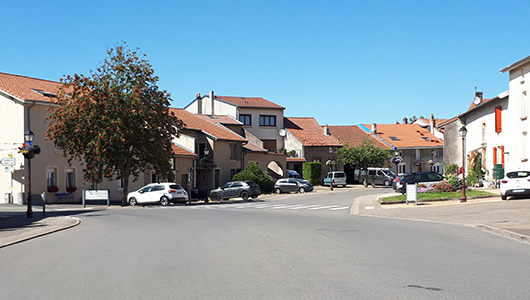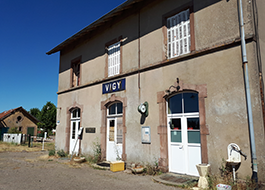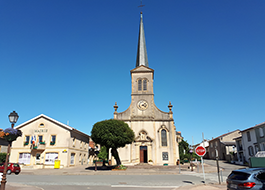Vigy
Durée visite : 30 minutes
Moyen : Pédestre
En 715, Vigy et ses terres ont été donnés à l’abbaye de Saint-Arnould de Metz. L’abbaye de Saint-Arnould avait comme couleurs le bleu et le jaune. Ce même bleu et jaune figurent actuellement sur le blason de la commune. En 1635, en pleine guerre de Trente ans, le village fut brûlé par les Espagnols. Les hommes, les femmes, les enfants, et le bétail périrent. Les soldats, commandés par le colonel Maillard, ne venaient pas de loin, car la région alors était voisine des Pays-Bas espagnols. Dans La Vie et rien d’autre, film réalisé par Bertrand Tavernier, une scène a été tournée à Vigy. On reconnaît Sabine Azéma dans la gare de Vigy.
In 715, Vigy and its lands were donated to the Abbey of Saint-Arnould in Metz. The abbey of Saint-Arnould had blue and yellow as colors. This same blue and yellow are currently on the coat of arms of the town. In 1635, in the midst of the Thirty Years’ War, the village was burnt down by the Spaniards. The men, women, children, and cattle perished. The soldiers, commanded by Colonel Maillard, did not come from far, because the region then was close to the Spanish Netherlands. In Life and Nothing Else, a film directed by Bertrand Tavernier, a scene was shot in Vigy. We recognize Sabine Azéma in Vigy station.
Im Jahr 715 wurden Vigy und sein Land der Abtei Saint-Arnould in Metz gestiftet. Die Abtei von Saint-Arnould hatte Blau und Gelb als Farben. Das gleiche Blau und Gelb befinden sich derzeit auf dem Wappen der Stadt. 1635, mitten im Dreißigjährigen Krieg, wurde das Dorf von den Spaniern niedergebrannt. Die Männer, Frauen, Kinder und Rinder kamen ums Leben. Die von Oberst Maillard kommandierten Soldaten kamen nicht von weit her, da die Region damals in der Nähe der spanischen Niederlande lag. In Life and Nothing Else, einem Film von Bertrand Tavernier, wurde eine Szene in Vigy gedreht. Wir erkennen Sabine Azéma in der Vigy Station.

D’azur à l’aigle essorante d’or, mi-parti fascé d’or et d’azur de huit pièces.
Ces armes, établies par la Commission départementale d’héraldique, ont été adoptées par la commune le 20 octobre 1948. Ce sont, à dextre les armes de l’abbaye de bénédictins de Saint-Arnould de Metz et, à sénestre, celles du paraige messin de Porte-Moselle. La seigneurie de Vigy appartint jusqu’à la Révolution à l’abbaye de Saint-Arnould, à laquelle elle avait été donnée en 715 par le duc Arnoul, fils de Drogon. Le plus ancien sceau de l’abbaye de Saint-Arnould (1372, arch. dép. Moselle G 1559) présente d’un côté, le saint en costume épiscopal, de l’autre, au contre-sceau, l’aigle, emblème de Saint Jean l’Evangéliste, avec la légende « in principio erat verbum ». C’est cette aigle, prise pour l’aigle impériale de la dynastie carolingienne, qui, au XVIIe siècle, a formé le blason de l’abbaye : « d’azur à l’aigle essorante d’or « , qui figure dans l’armorial d’Hozier (Meurgey, p. 135). Le village de Vigy était compris dans la partie du Pays messin appelée le Haut-Chemin, dépendant de la mairie de Porte-Moselle. C’est pour rappeler cette appartenance qu’ont été ajoutées les armes du paraige de Porte-Moselle ( V. A. Prost, Le Patriciat dans la cité de Metz, p. 244).
Azure, an eagle soaring gold, half-party fascé gold and Azure of eight pieces.
These weapons, established by the Departmental Commission of Heraldry, were adopted by the town on October 20, 1948. They are, on the right hand side the arms of the Benedictine abbey of Saint-Arnould de Metz and, on the other side, those of the paraige Metz from Porte-Moselle. The seigneury of Vigy belonged until the Revolution to the abbey of Saint-Arnould, to which it had been given in 715 by Duke Arnoul, son of Drogon. The oldest seal of the abbey of Saint-Arnould (1372, arch. Moselle department G 1559) presents on one side, the saint in episcopal costume, on the other, against the seal, the eagle, emblem of Saint John the Evangelist, with the caption “in principio erat verbum”. It is this eagle, taken for the imperial eagle of the Carolingian dynasty, which, in the sixteenth century, formed the coat of arms of the abbey: « azure to the eagle essorante d’or », which appears in the Hozier armorial (Meurgey, p. 135). The village of Vigy was included in the part of the Pays Metz called the Haut-Chemin, depending on the town hall of Porte-Moselle. It is to recall this membership that the arms of the paraige de Porte-Moselle have been added (see A. Prost, Le Patriciat dans la cité de Metz, p. 244).
Azure, ein hochfliegender Adler von Golden, Half-Party-Fascé von Golden und Azure aus acht Teilen.
Diese Waffen, die von der Abteilung für Heraldik eingerichtet wurden, wurden am 20. Oktober 1948 von der Stadt übernommen. Dies sind auf der rechten Seite die Waffen der Benediktinerabtei Saint-Arnould de Metz und auf der anderen Seite diese der paraige Metz von der Porte-Mosel. Das Seigneury von Vigy gehörte bis zur Revolution der Abtei von Saint-Arnould, der es 715 von Herzog Arnoul, dem Sohn von Drogon, übergeben worden war. Das älteste Siegel der Abtei von Saint-Arnould (1372, Arch. Moselabteilung G 1559) zeigt auf der einen Seite den Heiligen in bischöflicher Tracht, auf der anderen Seite gegen das Siegel den Adler, Emblem des Heiligen Johannes des Evangelisten, mit die Überschrift „in principio erat verbum“. Es ist dieser Adler, der für den Kaiseradler der karolingischen Dynastie genommen wurde und im 16. Jahrhundert das Wappen der Abtei bildete: « Azurblau für den Adler essorante d’or », der im Hozier-Wappen (Meurgey) erscheint S. 135). Das Dorf Vigy wurde in den Teil des Pays Metz aufgenommen, der Haut-Chemin genannt wird, abhängig vom Rathaus der Porte-Mosel. Um an diese Mitgliedschaft zu erinnern, wurden die Waffen der Paraige de Porte-Moselle hinzugefügt (siehe A. Prost, Le Patriciat dans la Cité de Metz, S. 244).

Les habitants et les habitantes de Vigy s’appellent les Torlas et les Torlasses.
The inhabitants of Vigy are called Torlas and Torlasses.
The inhabitants of Vigy are called Torlas and Torlasses.
Les points de visites
.
La ligne de chemin de fer Metz-Vigy-Anzeling a été inaugurée le 25 mars 1908, par le Président des chemins de fer d’Alsace-Lorraine. Le 1er avril suivant fut mise en circulation régulière la première locomotive à vapeur. Le tracé de la ligne est issu de l’un des deux tronçons d’itinéraires stratégiques, qui reliaient Metz à Anzeling via Vigy et Bettelainville à Merzig. L’Allemagne de Guillaume II voulait, en cas de nouvelle guerre avec la France, amener vite et facilement des troupes du Rhin, de la Sarre vers Metz et la frontière. La section Vigy à Bettelainville est abandonnée par la SNCF en 1976. Conscient de l’intérêt touristique du site, le département de la Moselle acquiert dès 1978 la ligne. Elle est confiée à l’association ALEMF en 1985, puis cédée en 1991. Depuis 1985, cette ligne de chemin de fer touristique de douze kilomètres, qui relie Vigy et Hombourg-Budange, traverse la vallée de la Canner en passant par la forêt de Saint-Hubert. Des anciennes gares de Vigy et de Hombourg-Budange sont les points de départ et d’arrivée.
The Metz-Vigy-Anzeling railway line was inaugurated on March 25, 1908, by the President of the Alsace-Lorraine railways. On the following April 1, the first steam locomotive was put into regular service. The route of the line came from one of the two sections of strategic routes, which linked Metz to Anzeling via Vigy and Bettelainville to Merzig. The Germany of William II wanted, in the event of a new war with France, to quickly and easily bring troops from the Rhine, from the Saar to Metz and the border. The Vigy section in Bettelainville was abandoned by the SNCF in 1976. Aware of the tourist interest of the site, the Moselle department acquired the line in 1978. It was entrusted to the ALEMF association in 1985, then sold in 1991. Since 1985, this twelve-kilometer tourist railway line, which links Vigy and Hombourg-Budange, has crossed the Canner valley via the Saint-Hubert forest. The old stations of Vigy and Hombourg-Budange are the starting points and arrival.
Die Eisenbahnlinie Metz-Vigy-Anzeling wurde am 25. März 1908 vom Präsidenten der elsässisch-lothringischen Eisenbahnen eingeweiht. Am folgenden 1. April wurde die erste Dampflokomotive in Betrieb genommen. Die Route der Linie kam von einem der beiden Abschnitte strategischer Routen, die Metz über Vigy und Bettelainville nach Merzig mit Anzeling verbanden. Das Deutschland Wilhelms II. Wollte im Falle eines neuen Krieges mit Frankreich schnell und einfach Truppen vom Rhein, von der Saar nach Metz und an die Grenze bringen. Der Vigy-Abschnitt in Bettelainville wurde 1976 von der SNCF aufgegeben. Das Mosel-Departement war sich des touristischen Interesses des Ortes bewusst und erwarb die Linie 1978. Es wurde 1985 der ALEMF-Vereinigung anvertraut und 1991 verkauft. Seit 1985 überquert diese zwölf Kilometer lange Touristenbahnlinie, die Vigy und Hombourg-Budange verbindet, das Canner-Tal über den Saint-Hubert-Wald. Die alten Bahnhöfe Vigy und Hombourg-Budange sind die Ausgangspunkte.
.
.
L’église Saint-Léger date de1868. Saint Léger vient du germanique Ledgar, qui signifie illustre à la guerre . Au VIIe siècle, il joua un rôle politique éminent à la cour d’Austrasie et à celle de Burgondie. Autrefois, lorsqu’un patient était atteint d’une maladie grave, on faisait toucher un de ses vêtements à la statue et aux reliques du saint, puis on jetait le vêtement dans la fontaine Saint-Léger. S’il surnageait, la guérison était proche mais s’il coulait, c’était la fin. Le Saint est donc le patron des malades. D’un point de vue extérieur, c’est surtout son clocher pointu, recouvert d’ardoise qui frappe l’œil du visiteur. A l’intérieur, vous découvrirez la même simplicité, à l’exception de la nef et du chœur, décorés par un Chemin de Croix en bois peint et des vitraux colorés de Victor Homec, maître-verrier originaire de Nancy. Dans les ailes du transept, on découvre deux statues,Vierge à l’Enfant et saint Joseph, en bois polychrome, entourées d’ornements sculptés. Quant au Christ de l’abside, il trône dans une niche inondée de lumière naturelle.
The Saint-Léger church dates from 1868. Saint Léger comes from the Germanic Ledgar, which means illustrious in war. In the 7th century, he played an eminent political role in the courts of Austrasia and that of Burgondia. In the past, when a patient had a serious illness, one of his clothes was touched to the statue and the relics of the saint, then the garment was thrown into the Saint-Léger fountain. If it floated, healing was near, but if it sank, it was the end. The Saint is therefore the patron of the sick. From an exterior point of view, it is above all its pointed steeple, covered with slate that catches the eye of the visitor. Inside, you will discover the same simplicity, with the exception of the nave and the choir, decorated with a painted wooden Way of the Cross and colored stained glass windows by Victor Homec, master glassmaker from Nancy. In the wings of the transept, we discover two statues, Madonna and Child and Saint Joseph, in polychrome wood, surrounded by carved ornaments. As for the Christ in the apse, he is enthroned in a niche flooded with natural light.
Die Saint-Léger-Kirche stammt aus dem Jahr 1868. Der Heilige Léger stammt aus dem germanischen Ledgar, was im Krieg berühmt bedeutet. Im 7. Jahrhundert spielte er eine herausragende politische Rolle an den Gerichten von Austrasien und Burgondia. In der Vergangenheit, als ein Patient eine schwere Krankheit hatte, berührte eine seiner Kleidungsstücke die Statue und die Reliquien des Heiligen, dann wurde das Kleidungsstück in den Saint-Léger-Brunnen geworfen. Wenn es schwebte, war die Heilung nahe, aber wenn es sank, war es das Ende. Der Heilige ist daher der Schutzpatron der Kranken. Von außen betrachtet ist es vor allem der spitze Kirchturm, der mit Schiefer bedeckt ist und die Aufmerksamkeit des Besuchers auf sich zieht. Im Inneren werden Sie die gleiche Einfachheit entdecken, mit Ausnahme des Kirchenschiffs und des Chores, die mit einem bemalten hölzernen Kreuzweg und farbigen Buntglasfenstern von Victor Homec, Glasmachermeister aus Nancy, verziert sind. In den Flügeln des Querschiffs entdecken wir zwei Statuen, Madonna und Kind und Saint Joseph, aus polychromem Holz, umgeben von geschnitzten Ornamenten. Der Christus in der Apsis thront in einer Nische, die von natürlichem Licht durchflutet ist.







